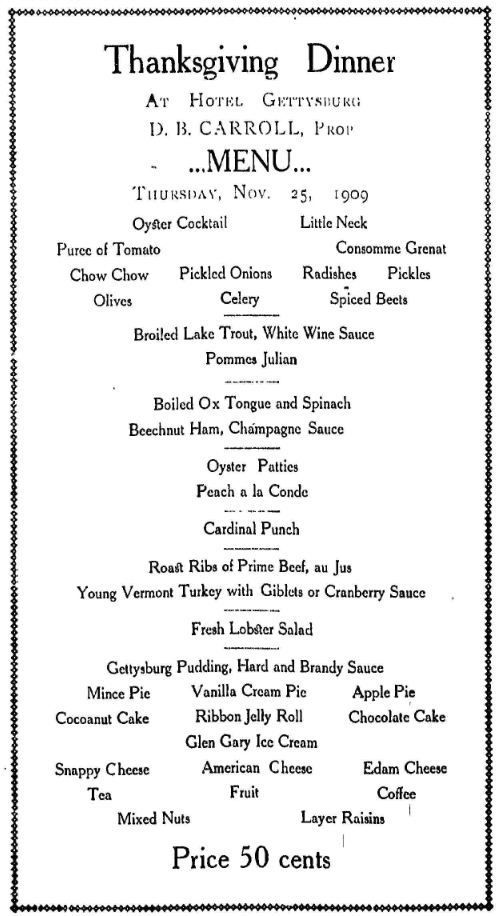It is November again, and the first thing that comes to mind for most Americans is Thanksgiving. This is one of the few times in the year when family, friends, and loved ones come together around the dinner table. This holiday can be traced to 1621, when the Plymouth settlers held a harvest feast after a fruitful growing season. During the following years, it became a civil tradition, passed down from generation to generation. The tradition has continued, but of course, prices have changed.
In 1909, the Gettysburg Hotel in Pennsylvania offered a Thanksgiving Buffet at the price of 50 cents per person. 107 years later, a similar Thanksgiving menu at the same hotel costs $30 per person. So, what happened between 1909 and 2016 with regard to long-term prices?

Thanksgiving menu (1909)
One major change was that in 1913, the Federal Reserve System was established in response to the crisis of 1907 with the aim of stabilizing the banking system. The Fed was charged with promoting maximum employment, stable prices, moderating long-term interest rates, and containing financial disruptions and their spread outside the financial sector. However, since the Fed’s creation, the value of the dollar has decreased notably, and its greatest declines tend to coincide with periods when the restraints imposed by the gold standard were relaxed.
The gold standard is a monetary system in which a country’s currency has a value directly linked to gold. From 1909 until the gold standard came to an end –when the interwar period and WWII forced some countries to abandon the convertibility of their currencies to gold— the inflation rate increased by 83 percent. After WWII, the Bretton Woods system established a pegged exchange rate tying the dollar to gold. During this period, the inflation rate rose by an impressive 180 percent. But since the 1971 Nixon shock —a series of economic measures undertaken by President Richard Nixon such as price and wage controls — and since the suspension of the direct convertibility of the dollar to gold until the present, prices have increased by 484 percent. Clearly, the Fed has a poor record of maintaining price stability.

Source: Lawrence H. Officer and Samuel H. Williamson, "The Annual Consumer Price Index for the United States, 1774-2014," MeasuringWorth, 2015.
So why did the U.S. abandon the gold standard? One reason might be that the gold standard prevented the federal government from printing excessive amounts of money, as it was obliged to redeem dollars in gold. Under the current fiat standard, in which the value of the currency is fixed by government regulation and is not backed by a commodity, the supply of money is dictated by discretionarydecisions of the Federal Open Market Committee (FOMC). And as there are no rules, principles or statutory constraints to stick to once it declares a financial emergency, it can expand credit as it pleases.
The Fed could not even stick to the employment objective. The average unemployment rate, which reached approximately 5% between 1870 and the creation of the Fed, rose to 6.4% since the end of the Bretton Woods system until the present. It is also worth mentioning that since the Fed became a Lender of Last Resort (LOLR), banking panics diminished after 1933.
The LOLR mandate increased the incentives for private banks not to act responsibly, thus inducing moral hazard —circumstances in which one party gets involved in risky events knowing that someone else will incur the cost. In this case, financial bailouts can encourage risky lending if private banks come to believe that they will not have to carry the full burden of potential losses. It should not be surprising, then, that more outbreaks of bank failures occurred in the hundred years after the Fed was created than the hundred years before.
The old system was not ideal; but if in 1907 people thought that it needed to be changed, there is just as much reason –if not more– for thinking that today. Why should people leave the control of money to the same institution that got the U.S. into the Great Depression and the last financial crisis? Central bankers exercising wide discretion in monetary policy do not deliver better economic results. Inflation, financial crises, capital losses, and price bubbles are one of the most painful consequences of the use of discretionary monetary policies that particularly affect the poor. It is important to stand up for disciplined and responsible monetary practices that restrict the printing of money. Keeping high inflation rates away from future Thanksgiving dinners or from affecting other goods and services would be something for which we would all be grateful.
